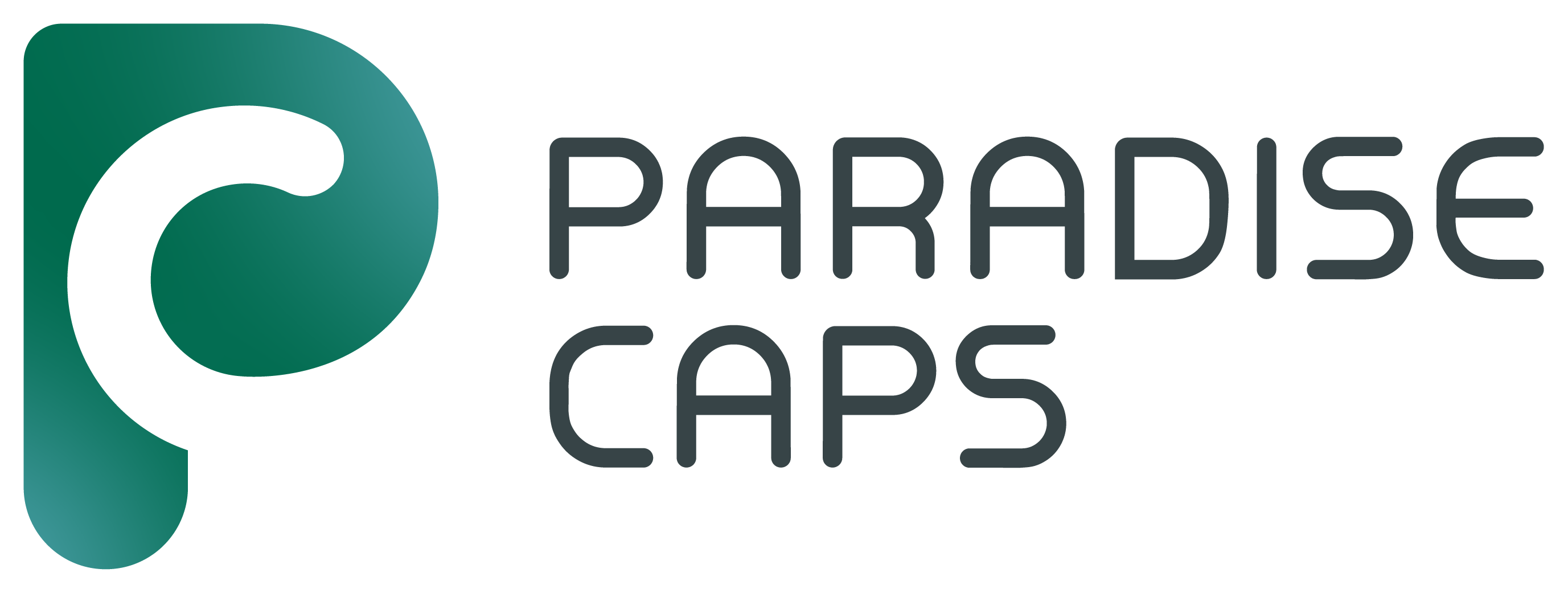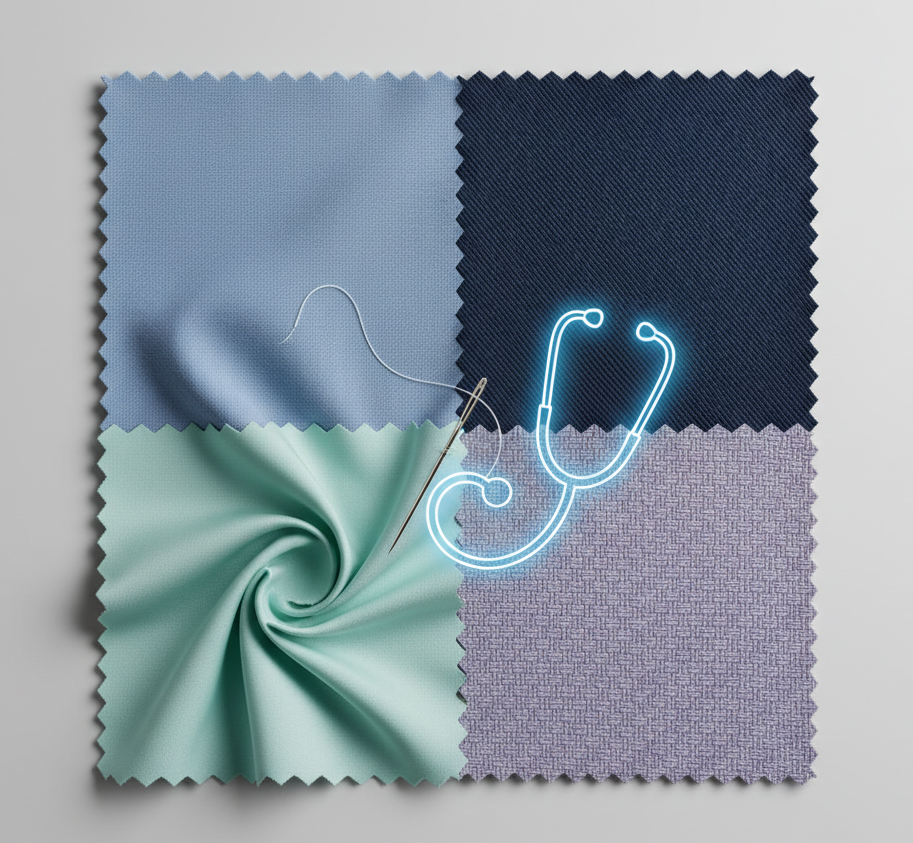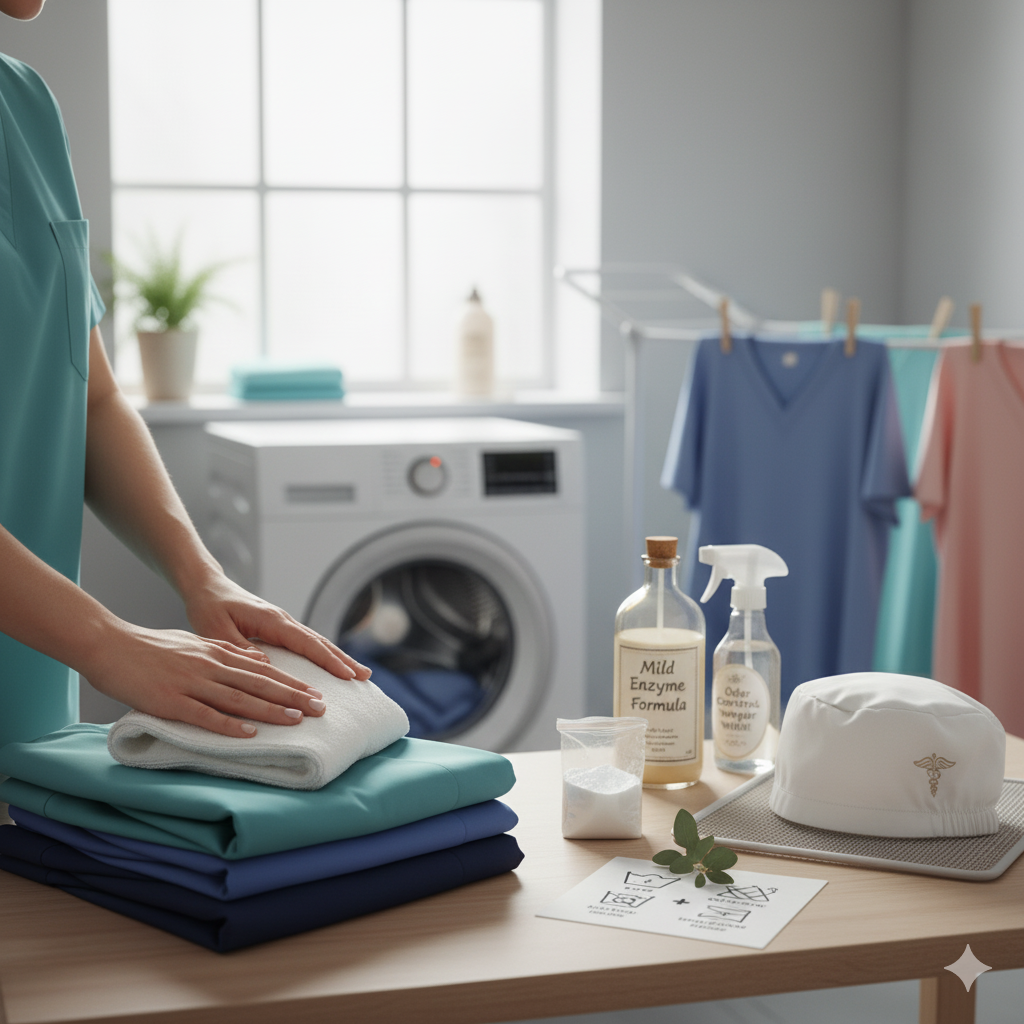Fabric for Scrubs: Best Materials for Medical Uniforms
Have you ever caught yourself halfway through a 12-hour shift, realizing that your scrubs are making it harder, not easier, to focus?
We rarely think about it, but the uniform cloth material silently shapes how well we perform, how hygienic we stay, and how confident we feel during every patient interaction.
It’s not just about how they look. It’s about:
- Breathability under pressure
- Durability after 50+ washes
- Movement when space is tight
- Hygiene at all times
- Comfort that lasts through every single heartbeat
This isn’t a post about style trends or colors. It’s a practical, detail-heavy, human-written guide about what really matters when choosing scrub fabric — whether you’re buying for yourself or outfitting an entire clinical team.
We’re going deep on textile science and surface-level sensibility — to help you find the best material for scrubs (and caps!) that you’ll want to rely on every day.
Types of Fibers
Every fabric starts with a fiber — the raw material that gives your uniform its base personality.
It’s the difference between bending easily and feeling stiff. Between staying dry or becoming a sponge. If you're wondering what are scrubs made of — you're really asking what material are scrubs made of.
Let’s break the main ones down — candidly, with a healthcare worker in mind.
Natural Cotton
Imagine a long shift in July. Your back’s warm. You’re moving constantly, up and down. Cotton helps.
Strengths:
- Breathable in hot or closed environments
- Doesn’t irritate even sensitive skin
- Handles sweat without locking it in
- Naturally hypoallergenic
Watch outs:
- Tends to wrinkle, especially 100% cotton
- More prone to wear/fade without synthetic blend
- Can shrink with high-heat laundry, unless pre-treated
That said — when it comes to scrub cap fabric, especially for surgical workers or those working under lights for hours, cotton is still one of the best. It’s not flashy. It just works.
Durable Polyester
Want clean lines? A scrub set that doesn’t shrink? A scrub cap that holds its shape no matter how many times you wash it?
That’s where polyester shows up.
Made from petroleum-derived synthetics, polyester fabric for medical scrubs is long-lasting and impressively low maintenance.
It’s the quiet multitasker in most uniforms: it keeps structure, keeps color, keeps you from having to iron before that 6am start.
Pros:
- Bright colors stay bright — even after dozens of washes
- Resists most superficial stains (especially if coated)
- Fast drying — you can wash it in the morning, wear it by lunchtime
- Fewer wrinkles, meaning less need for ironing
- Excellent shape retention, especially for scrub caps where you need the cap to hold structure under other gear
Cons:
- Not as breathable as natural fabrics
- Can build up static electricity
- Sometimes traps odors, especially if not treated with performance finishes
Polyester is an ideal choice for high-turnover, budget-friendly, frequently washed scrub uniforms — especially in hospital settings where uniformity and structure matter. But for comfort, look for blends. On its own, polyester can feel “closed off,” especially in heat.
Stretchy Spandex
Now, picture yourself as a medical assistant constantly switching gears—acting as a go-between from the exam room to a tight hallway, then back to a patient’s bedside. You squat, lean, twist.
Stretch is your friend.
What it offers:
- Multi-directional elasticity
- Keeps its shape—your knees, elbows, and shoulders won’t sag
- Helps a scrub cap stay snug on the head (especially with tie-back designs)
- Essential for tailored silhouettes—it holds without squeezing
Drawbacks:
- Doesn’t tolerate high-heat washing well (can degrade over time)
- Usually used in small amounts (2–10%)
- Too smooth/slippery on its own—works best blended with other fibers
Even 5% spandex transforms the feel and performance of a fabric. Ideal for active professionals — from EMTs to pediatric specialists.
Soft Rayon
Rayon is a unique material. Technically “semi-synthetic,” it’s made from natural wood pulp that undergoes chemical processing.
In practice, it’s easily the softest fabric used in scrubs.
Advantages:
- Drapes beautifully — perfect in scrub tops and scrub caps
- Incredibly soft, great for sensitive or reactive skin
- Lightweight and breathable — pairs well with synthetic fibers
- Common in women’s scrubs and scrub cap styles for its softness and grace
What to keep in mind:
- Requires delicate washing — can shrink if mishandled
- Wrinkles easily unless blended
- Not durable on its own — usually combined with polyester for best results
Fabric Blends
One of the biggest advantages of today’s medical uniforms is that you no longer have to choose between breathability and durability, or between stretch and structure. Why? Because blends do the heavy lifting.
By mixing fibers like cotton, polyester, spandex, and rayon, scrub manufacturers are able to fine-tune how the fabric feels and behaves. Need stretch without sagging? Done. Want something that breathes but also survives heavy laundry cycles? That’s in the mix too.
These blended fabrics are designed to move with you, hold their shape, and feel just as comfortable at the end of your shift as they did at the beginning.
Polyester and Cotton Mix
This is probably the most classic, reliable blend in the world of fabric for scrubs uniforms. The goal is simple: combine the strength and low-maintenance of polyester with the comfort and breathability of cotton. The typical formula? About 65% polyester, 35% cotton—but it can vary.
Why this blend works:
- It resists wrinkles and keeps its shape inside and outside the wash
- It feels lighter and cooler than 100% polyester
- It absorbs sweat better, thanks to the cotton
- It fades less and lasts longer than 100% cotton
- It strikes a perfect middle ground between structure and softness
Is there a downside? Only if you're in a hot climate with no air circulation. Even the best blend can't deliver the breathability of pure cotton, so if you're hyper-sensitive to heat or prone to sweating, you may prefer a cotton-dominant ratio.
Polyester with Spandex
You’ll usually find 3–10% spandex in these blends, depending on the brand and product.
Why you’ll love this blend:
- Smooth and soft on the skin
- Feels like athletic wear—but made for clinical work
- Doesn’t bind when you crouch, squat, pivot, or lean
- Makes for sleek, tailored looks without feeling tight
- Stays presentable without constant ironing
Watch for: This blend may trap heat more than a natural-fiber option, especially if used in heavier weaves. So it’s perfect for colder buildings or fast-paced jobs, but less ideal for hot outpatient clinics without temperature control.
Fabric Weaves
It’s easy to forget that fabric isn’t just what it’s made of—but how it's made.
The weave determines everything from texture and drape to stain resistance and how the fabric performs after repeated washing. Think of the weave as the architecture of the material. Even two fabrics made from the same fiber can feel completely different depending on how they’re woven.
Smooth Poplin
In fabric for nurses, poplin is a top choice—it looks polished, doesn’t cling, and holds up beautifully across color ranges and print designs.
What makes poplin great:
- Smooth, highly uniform surface
- Lightweight, breathable texture
- Doesn’t retain debris, dust, or lint
- Perfect for embroidered logos or emblems
- Resistant to puckering at seams, even in scrub caps
Textured Dobby
Dobby isn’t a fiber—it’s a weaving method that creates subtle geometric patterns or textures within the material. It’s visual, but not flashy.
Why it works:
- Offers subtle structure without stiffness
- Adds interest to solid-color scrubs
- Drapes well, especially in slightly heavier weights
- Provides gentle breathability
- Useful in scrub cap fabric where texture hides wear
Dobby might not be as soft as rayon blends or as light as poplin, but it's a favorite in designs. Dobby might not be as soft as rayon blends or as light as poplin, but it's a favorite in designs where subtle elegance and texture matter. Think of uniforms in high-profile clinics, cosmetic dermatology offices, or dental practices where presentation still needs to align with fast-paced clinical function.
In scrub caps, dobby-weave fabrics have one very practical upside: they hide wear. Slight spotting, forehead sweat, or lint doesn’t show up as easily on a lightly textured surface. That means your cap keeps looking polished even after multiple wears.
Sturdy Twill
Twill is the heavy lifter — literally. You know that slight diagonal ridge you can see and feel in denim? That’s twill. It’s durable, built for friction, and often used where uniforms are exposed to tougher wear.
In medical scrub fabric, twill gets chosen when fading, pilling, or wear-through are a concern. It also offers a sophisticated drape for full-length pants or tailored jackets.
Twill highlights:
- Distinctive diagonal weave resists tearing
- Hides dirt and stains surprisingly well
- Doesn’t wrinkle easily
- Great structure for fitted tops and pants
- Long-term durability for fabric for scrub uniforms
Textile Finishes and Enhancements
Once the base fabric has been created — fibers spun, blended, and woven — there’s still one crucial layer that can elevate it from “functional” to “truly performance-ready”: finishings.
Textile enhancements are chemical or physical treatments applied to fabric after production. These add features like antimicrobial defense, stain resistance, or wrinkle fighting.
Let’s walk through the most important ones used in medical fabric material — and how they especially matter in sweat-prone zones like scrub caps.
Common Finishes to Know:
- Antimicrobial Coating: Prevents bacteria from building up in warm, damp areas — essential in scrub caps and uniforms used in surgery, pediatrics, or high-touch care
- Moisture-Wicking Technology: Pulls sweat to the surface and evaporates it faster — preventing sweat rings or that clingy discomfort in both caps and tops
- Stain-Resistance Finishes: Makes it easier to wash off blood, ink, or antiseptic fluids before they set
- Anti-Static Treatment: Especially useful around medical electronics — reduces cling from PPE and prevents irritating static buildup
- Wrinkle Resistance: Helps your uniform stay crisp, even straight out of the dryer
- Colorfast Treatment: Keeps dye from bleeding or fading — extending the professionalism of bright or dark-colored scrubs
- Softening/Brushed Finish: Improves comfort after repeated washing, adds a lightly velvety surface
Key Criteria for Selecting the Best Fabric for Scrubs
You’ve got fibers, blends, weave types, and finishes. But how do you actually choose? Let’s zoom out.
Whether you’re evaluating scrub fabric for a hospital-wide uniform policy or just looking for your next favorite head cap, here are the universal criteria you should consider.
Airflow and Breathability
No one concentrates well when they’re overheating. Especially not in PPE. That’s why breathable material — whether in the back panel of your top or the crown of your scrub cap — makes a major difference.
Best bets:
- Pure or high-percentage cotton
- Rayon dominant blends
- Poplin weave
- Any fabric with a ventilated, mesh, or moisture-wicking finish
Elasticity and Freedom of Movement
If your work includes reaching, bending, assisting, or adjusting patients — stretch helps. Movement can’t just come from the pattern — the scrub fabric needs to follow your motion, not fight it.
Best bets:
- Poly-spandex blends (5%+ spandex content)
- Rayon-spandex for extra softness
- Mechanical stretch designs in twill weaves
Strength and Wear Resistance
Let’s face it: scrubs go through a lot. Wash cycles. Bleach. Bending. Pulling. Coffee. Pressure. If the fabric can't keep up, neither can your workflow.
Strength doesn't always mean heaviness — but it does mean resisting thinning, fraying, or pilling over time.
Best bets:
- Polyester-dominant blends
- Twill weave for pants or reinforced caps
- Blends with tightly woven construction
- Avoid flimsy rayon without structural partners like poly
For scrub caps especially, strength often shows up in the headband area and ties.
Moisture Management
The right material needs to handle all of that sweat.
How to spot it:
- Labels that note “moisture-wicking” or “quick dry”
- Poly-cotton blends with performance finishes
- Brushed or dual-surface fabrics (smooth outside, moisture-control inside)
- Many modern scrub caps come with sweatbands or wicking interiors — don’t skip them
Even minor improvements in moisture handling can mean fewer skin issues, less heat fatigue, and way more focus in surgery.
Antimicrobial Protection
There’s a reason this finish has become a staple in medical fabric materials: even with PPE and standardized sanitization, uniforms still face constant exposure to bacteria, fungus, and fluids.
Where it matters most:
- Inside the neckline, armpits, or nape area
- Scrub pockets (yes — those unwashed pen holders)
- Crown and headband zones of scrub caps
- Environments with high patient load or long turnaround times
Look for certified finishes (like Silvadur®), or products that advertise “antimicrobial tested for 20+ washes.”
Resistance to Stains
No one wants to look sloppy halfway through a shift. Stain-repellent fabrics help repel the worst offenders — like iodine, pen ink, or that impossible-to-was-out soup from the hospital café.
Pro tips:
- Look for “fluid barrier” or “stain release” wording
- Twill and dobby hold subtle stains better than poplin
- In scrub caps, prioritize this if you're working in surgery, OR, or peds
Eco-Friendliness
Eco-aware healthcare workers aren’t only watching their energy use and reusables — many are starting to rethink the fabric for scrubs uniforms too.
The good news? Sustainable options are getting better — and more affordable.
And yes — there are eco-conscious scrub caps too. Especially ones made in small batches by independent vendors who prioritize ethical sourcing. You might even be wearing one right now.
Anti-Static Performance
Anti-static treated fabrics help prevent garment cling, signal interference, and the infamous “shock zap” when touching equipment or a colleague.
Especially important in:
- Tech-heavy clinics
- Cardiology or telemetry departments
- X-ray, radiography, and surgical supervision
- Polyester-heavy uniforms (which naturally build more static)
In scrub caps, it’s an underrated perk — particularly in mask-integrated caps that sit right behind audio/lab gear or comms systems.
Why Scrub Fabric Is More Than Just Material
Your scrubs are a second skin. They protect you. They carry you through long hours when your own energy fades. They communicate trust, cleanliness, professionalism — long before you speak a word.
So no, your scrub material fabric is not just a technicality. It’s a toolkit.
The material you choose touches everything: how you move, how you stay cool under stress, how much laundry you do, how often you buy new sets, and yes — how your hair feels beneath your scrub cap after 12 hours in motion.
The right fabric for scrub caps offers more than just cover. It holds hair in place without pulling, keeps heat out of your forehead, manages moisture, and lets your personality show in a room full of gowns and gloves.



